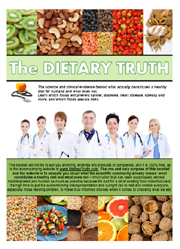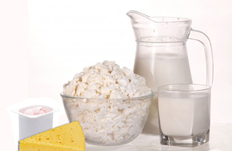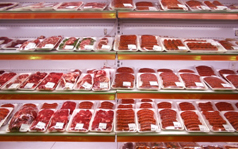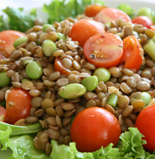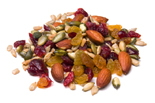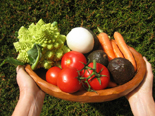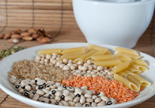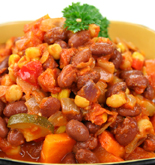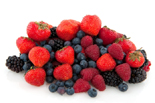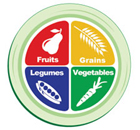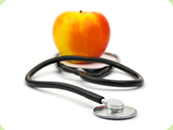

The science and clinical evidence behind what actually constitutes a healthy diet for humans and what does not.
Learn which foods will prevent cancer, diabetes, heart disease, obesity and more, and which foods elevate risks.
Please note: The following information contains references to the medical studies/articles supporting claims made. The studies are by no means cherry-picked and the evidence for many claims is so overwhelmingly corroborated we frequently mention multiple sources for the same statements. If you wish to review these medical studies/articles as you read the information, please click on the citations within the text to view the associated link for each study’s abstract/full version, as available. Let’s
start with the key components of the typical American diet –
dairy, meat, fish and eggs.
BONE
HEALTH AND OSTEOPOROSIS CANCER
RISK AND PARKINSON’S DISEASE ACNE ALUMINUM
POISONING ANTIOXIDANT
BLOCKER EARLY
ONSET OF PUBERTY BREAST,
OVARIAN, CORPUS UTERI CANCERS AND MALE REPRODUCTIVE DISORDERS TESTICULAR
AND PROSTATIC CANCERS STEROID
HORMONES DAIRY
SUMMARY
BLADDER,
BREAST, PANCREATIC, ENDOMETRIAL, OVARIAN, LUNG, THROAT, STOMACH AND
ESOPHAGEAL CANCERS FLAME
RETARDANTS IN BREAST MILK HETEROCYCLIC
AMINES (HCAs) IN COOKED MEAT ASTHMA
AND GRILLED/SMOKED MEATS ESSENTIAL
TREMOR INFERTILITY
IN WOMEN AGING
ACCELERATION ARSENIC HEPATITIS
E MRSA,
E. COLI AND RAW MEAT
RESIDUAL
VETERINARY DRUGS, PESTICIDES AND HEAVY METALS ALZHEIMER’S
DISEASE AND COPPER DIABETES BREAST
CANCER HORMONAL
STEROIDS AND HORMONE-RELATED CANCERS ANABOLICS
(GROWTH PROMOTING STEROIDS) EARLY
ONSET OF PUBERTY MEAT
IN HOT DOGS AND HAMBURGERS E.
COLI, SALMONELLA AND AMMONIA MEAT
SUMMARY “The beef industry has contributed to more American deaths than all the wars of this century, all natural disasters, and all automobile accidents combined. If beef is your idea of ‘real food for real people’ you'd better live real close to a real good hospital.” - Neal Barnard, M.D.
PREGNANT
WOMEN MERCURY DIOXINS,
ARSENIC, PCB’S, PARASITIC WORMS AND DRUGS DHA
AND FISH OIL FISH
SUMMARY
ESTROGEN FAT
AND CHOLESTEROL DIABETES ALLERGY ANTIOBITIOC
RESISTANCE SALMONELLA MOUTH,
THROAT, ESOPHAGEAL, COLON, RECTAL, LUNG, BREAST, BLADDER, AND
PROSTATE CANCER, AS WELL AS ALL CANCERS COMBINED EGG
SUMMARY
“Choose a diet that is predominantly plant-based, rich in a variety of fruits, vegetables, nuts and beans with minimally processed starchy foods” - AICR/WCRF Expert Report: Food, Nutrition and the Prevention of Cancer The above quote is by the world’s foremost experts on human nutrition, and cancer and disease prevention, and after countless, ongoing medical trial and study reviews, this has remained their position for over 20 years. THE HEALTHIEST DIET IN DETAIL So
the healthiest diet is a whole food plant-based diet rich in fruits,
veggies, nuts and beans, with a reliable source of vitamin B12.
PLANNING
A MEAL AND THE POWER PLATE
Of course, not all meals need to follow this layout; for simple snacks or small meals, hummus and crackers, veggies, fresh/dried fruits, nuts, etc. are just perfect. But for your main meal(s) of the day, this approach will balance out your meals best, assuring a good source of protein, calories, vital nutrients and antioxidants.
ADDITIONAL TIPS TO MAXIMIZE HEALTH
Following
a whole food plant-based diet certainly has its benefits:
"Vegetarians
have the best diet. They have the lowest rates of coronary disease of
any group in the country... a fraction of our heart attack rate and
they have only 40 percent of our cancer rate."
PROTECTION
FROM CANCERS, STROKE, OBESITY, DIABETES, AND MORE… PLANT-BASED
DIET AS THE CANCER AND DIABETES PREVENTATIVE PLANT-BASED
DIET AS THE CANCER AND DIABETES TREATMENT MISCELLANEOUS BENEFITS
LASTLY,
THE
MOST FREQUENTLY ASKED QUESTION WHEN FACED WITH THE FACTS: CAN’T
WE JUST CONTINUE TO CONSUME ANIMAL PRODUCTS BUT SIMPLY ADD LOTS OF
FRUITS AND VEGGIES TO OUR MEAT-BASED DIET?
For more
information, research updates, many excellent additional resources,
free recipes, help for parents of picky eaters and those feeding
babies, plant-based equivalents for common food items, and dispelled
myths, please browse through our additional pages featured on your left hand panel at the top of the page. MEDICAL DISCLAIMER: Information provided in this booklet and on the accompanying website at www.DietaryTruth.com is for informational purposes only; it is not intended as a substitute for advice from your own medical team. The information provided is not to be used for diagnosing or treating any health concerns you may have - please contact your physician or health care professional for all your medical needs. 1 Sci Am, Jan 2003 3 Veganism, bone mineral density, and body composition: a study in Buddhist nuns, Osteoporosis International Volume 20, Number 12, 2087-2093, DOI: 10.1007/s00198-009-0916-z 4 Plasma and erythrocyte biomarkers of dairy fat intake and risk of ischemic heart disease, American Journal of Clinical Nutrition, Vol. 86, No. 4, 929-937, October 2007 5 Childhood dairy intake and adult cancer risk: 65-y follow-up of the Boyd Orr cohort, Am J Clin Nutr. 2007 Dec;86(6):1722-9. 6 A prospective study of dietary calcium, dairy products and prostate cancer risk, Int J Cancer. 2007 Jun 1;120(11):2466-73. 7 Adolescent milk fat and galactose consumption and testicular germ cell cancer, Cancer Epidemiol Biomarkers Prev. 2006 Nov;15(11):2189-95. 8 Consumption of Dairy Products and Risk of Parkinson's Disease, Am. J. Epidemiol. (2007) 165 (9): 998-1006. doi: 10.1093/aje/kwk089 First published online: January 31, 2007 9 Milk consumption and acne in teenaged boys, J Am Acad Dermatol. 2008 May;58(5):787-93. Epub 2008 Jan 14. 11 Milk consumption and acne in adolescent girls, Dermatology Online Journal 12 (4): 1 12 Aluminum bioavailability from basic sodium aluminum phosphate, an approved food additive emulsifying agent, incorporated in cheese, Food Chem Toxicol. 2008 Jun;46(6):2261-6. Epub 2008 Mar 10. 13 Antioxidant status in humans after consumption of blackberry juices with and without defatted milk, J Agric Food Chem. 2008 Dec 24;56(24):11727-33. 14 Antioxidant activity of blueberry fruit is impaired by association with milk, Free Radic Biol Med. 2009 Mar 15;46(6):769-74. Epub 2008 Dec 11. 15 Exposure to exogenous estrogen through intake of commercial milk produced from pregnant cows, Pediatr Int. 2010 Feb;52(1):33-8. Epub 2009 May 22. 16 Dietary Protein Intake throughout Childhood Is Associated with the Timing of Puberty, J. Nutr. First published December 30, 2009; doi:10.3945/jn.109.114934 17 Impaired Perinatal Growth and Longevity: A Life History Perspective, Curr Gerontol Geriatr Res. 2009; 2009: 608740 18 The possible role of female sex hormones in milk from pregnant cows in the development of breast, ovarian and corpus uteri cancers., Med Hypotheses. 2005;65(6):1028-37. Epub 2005 Aug 24. 19 Is milk responsible for male reproductive disorders?, Med Hypotheses. 2001 Oct;57(4):510-4. 20 Incidence and mortality of testicular and prostatic cancers in relation to world dietary practices., Int J Cancer. 2002 Mar 10;98(2):262-7. 21 Diet and acne: a review of the evidence, International Journal of Dermatology, 48: 339–347. doi: 10.1111/j.1365-4632.2009.04002.x 22 Milk consumption: aggravating factor of acne and promoter of chronic diseases of Western societies, J Dtsch Dermatol Ges. 2009 Apr;7(4):364-70. Epub 2008 Feb 20. 23 Acne, Dairy and Cancer, Dermato-Endocrinology 1:1, 12-16; January/February 2009 24 Meat intake and bladder cancer risk in 2 prospective cohort studies, American Journal of Clinical Nutrition, Vol. 84, No. 5, 1177-1183, November 2006 25 Dietary mutagen exposure and risk of pancreatic cancer, Cancer Epidemiology, Biomarkers & Prevention April 2007 16;655 doi: 10.1158/1055-9965.EPI-06-0993 26 Cooked meat and risk of breast cancer lifetime vs recent dietary intake, Epidemiology. 2007 May;18(3):373-82. 27 Animal food intake and cooking methods in relation to endometrial cancer risk in Shanghai, Br J Cancer. 2006 December 4; 95(11): 1586–1592. doi: 10.1038/sj.bjc.6603458. Published online 2006 November 28. 28 Meat consumption and risk of breast cancer in the UK women's cohort study, British Journal of Cancer (2007) 96, 1139–1146. doi:10.1038/sj.bjc.6603689 Published online 3 April 2007 29 Brominated flame retardants in US food, Mol Nutr Food Res. 2008 Feb;52(2):266-72. 30 An Exposure Assessment of Polybrominated Diphenyl Ethers (External Review Draft), U.S. Environmental Protection Agency, Washington, D.C., EPA/600/R-08/086A 31 Polybrominated diphenyl ether (PBDE) levels in an expanded market basket survey of U.S. food and estimated PBDE dietary intake by age and sex, Environ Health Perspect. Oct;114(10):1515-20. 32 “Beware of Cancer Risks in this Supposed Health Food”, Cancer News You Need to Know | October 2010, Accessed October 29, 2010 33 Genotoxicity of heat-processed foods. Mutation Research 2005; 574(1–2):156–172. 34 Heterocyclic amines: Mutagens/carcinogens produced during cooking of meat and fish. Cancer Science 2004; 95(4):290–299. 35 Serum Polycyclic Aromatic Hydrocarbons among Children with and without Asthma: Correlation to Environmental and Dietary Factors, Int J Occup Med Environ Health. 2008;21(3):211-7. 36 Dietary Epidemiology of Essential Tremor: Meat Consumption and Meat Cooking Practices, Neuroepidemiology 2008;30:161-166 (DOI: 10.1159/000122333) 37 Protein Intake and Ovulatory Infertility, Am J Obstet Gynecol. 2008 Feb;198(2):210.e1-7. 38 Dietary patterns, food groups, and telomere length in the Multi-Ethnic Study of Atherosclerosis (MESA), Am J Clin Nutr 2008 88: 1405-1412 39 Levels of Arsenic in the United States Food Supply, Environ Health Perspect. 1977 Aug;19:83-7. 40 Much meat, much malady: changing perceptions of the epidemiology of hepatitis E, Clin Microbiol Infect. 2010 Jan;16(1):24-32. 41 Isolation and characterization of methicillin-resistant Staphylococcus aureus strains from Louisiana retail meats, Appl Environ Microbiol. 2009 Jan;75(1):265-7. Epub 2008 Oct 31. 42 Antimicrobial-resistant and extraintestinal pathogenic Escherichia coli in retail foods, J Infect Dis. 2005 Apr 1;191(7):1040-9. Epub 2005 Mar 1. 43 FSIS National Residue Program for Cattle, Accessed October 29, 2010 44 The Risks of Copper Toxicity Contributing to Cognitive Decline in the Aging Population and to Alzheimer's Disease, J Am Coll Nutr 2009 28: 238-242 45 Meats, Processed Meats, Obesity, Weight Gain and Occurrence of Diabetes among Adults: Findings from Adventist Health Studies, Nutr Metab 2008;52:96-104 (DOI: 10.1159/000121365) 46 The possible role of female sex hormones in milk from pregnant cows in the development of breast, ovarian and corpus uteri cancers, Med Hypotheses. 2005;65(6):1028-37. Epub 2005 Aug 24. 47 Meat consumption and risk of breast cancer in the UK women's cohort study, British Journal of Cancer (2007) 96, 1139–1146. doi:10.1038/sj.bjc.6603689 Published online 3 April 2007 48 Estrogen concentrations in beef and human hormone-dependent cancers, Ann Oncol (2009) 20 (9): 1610-1611. doi: 10.1093/annonc/mdp381 First published online: July 23, 2009 49 Prevalence of Diabetes among Men and Women in China, N Engl J Med 2010; 362:1090-1101 March 25, 2010. 50 Hormonal growth promoting agents in food producing animals, Handb Exp Pharmacol. 2010;(195):355-67. 51 Assessment of endogenous androgen levels in meat, liver and testis of Iranian native cross-breed male sheep and bull by gas chromatography-mass spectrometry, Food Addit Contam Part A Chem Anal Control Expo Risk Assess. 2009 Apr;26(4):453-65. 52 Consequence of boar edible tissue consumption on urinary profiles of nandrolone metabolites. II. Identification and quantification of 19-norsteroids responsible for 19-norandrosterone and 19-noretiocholanolone excretion in human urine, Rapid Communications in Mass Spectrometry, 15: 1442–1447. doi: 10.1002/rcm.391 53 Body fat and animal protein intakes are associated with adrenal androgen secretion in children, Am J Clin Nutr 90: 1321-1328, 2009. First published September 30, 2009; doi:10.3945/ajcn.2009.27964 54 Fast food hamburgers: what are we really eating?, Annals of Diagnostic Pathology, Vol 12 Issue 6, Pages 406-409, Dec 2008 55 Applying morphologic techniques to evaluate hotdogs: what is in the hotdogs we eat?, Ann Diagn Pathol. 2008 Apr;12(2):98-102. Epub 2007 Oct 24. 56 Safety of Beef Processing Method Is Questioned, New York Times, December 30, 2009, Michael Moss, Accessed October 29, 2010 57 Public Health and Economic Consequences of Methyl Mercury Toxicity to the Developing Brain, Environ Health Perspect. 2005 May; 113(5): 590–596. doi: 10.1289/ehp.7743. Published online 2005 February 28. 58 Nowhere to hide: Chemical toxicants and the unborn child, Reproductive Toxicology 28 (2009) 115–116 59 Sub-Clinical Neurobehavioral Abnormalities Associated with Low Level of Mercury Exposure through Fish Consumption, Neurotoxicology. 2003 Aug;24(4-5):617-23. 60 Amnesia, Political Ambition, and Canned Tuna, Accessed October 29, 2010 61 Fish consumption, methylmercury and child neurodevelopment, Curr Opin Pediatr. 2008 Apr;20(2):178-83. 62 Intake of dioxins and related compounds from food in the U.S. population, Journal of Toxicology and Environmental Health, Part A, 63:1–18, 2001 63 Exploration of biomarkers for total fish intake in pregnant Norwegian women, Public Health Nutr. 2010 Jan;13(1):54-62. Epub 2009 Jun 3. 64 Dioxins, polychlorinated biphenyls, methyl mercury andomega-3 polyunsaturated fatty acids as biomarkers of fish consumption, Eur J Clin Nutr. 2010 Mar;64(3):313-23. Epub 2010 Jan 27. 65 Mercury in human hair as an indicator of the fish consumption, Neuro Endocrinol Lett. 2008 Oct;29(5):675-9. 66 Pharmed Fish, Accessed October 29, 2010 67 No effect of fish oil supplementation on serum inflammatory markers and their interrelationships; a randomized controlled trial in healthy, middle-aged individuals, European Journal of Clinical Nutrition (2009) 63, 1353–1359; doi:10.1038/ejcn.2009.63; published online 22 July 2009 68 Hormonal growth promoting agents in food producing animals, Handb Exp Pharmacol. 2010;(195):355-67 69
Egg
consumption and risk of type 2 diabetes in men and women,
Diabetes Care. 2009 Feb; 32(2):295-300
70 Royal Prince Alfred Hospital’s Egg Allergy Brochure, Accessed October 29, 2010 71 Playing chicken with antibiotics, Accessed October 29, 2010 72 Salmonella Enteritidis Infection, Accessed October 29, 2010 73 Egg consumption and the risk of cancer: a multisite case-control study in Uruguay, Asian Pac J Cancer Prev. 2009;10(5):869-76. 74 Dietary fibre and risk of breast cancer in the UK Women's Cohort Study, Int. J. Epidemiol. (2007) 36 (2): 431-438. doi: 10.1093/ije/dyl295 First published online: January 24, 2007 75 Cooked meat and risk of breast cancer lifetime vs recent dietary intake, Epidemiology. 2007 May;18(3):373-82. 76 Nutritional factors in relation to endometrial cancer: A report from a population-based case-control study in Shanghai, China, Int J Cancer. 2007 April 15; 120(8): 1776–1781. doi: 10.1002/ijc.22456. 77 Animal food intake and cooking methods in relation to endometrial cancer risk in Shanghai, Br J Cancer. 2006 December 4; 95(11): 1586–1592. doi: 10.1038/sj.bjc.6603458. Published online 2006 November 28. 78 A Diet High in Fruits and Low in Meats Reduces the Risk of Colorectal Adenomas, J. Nutr. 2007 137: 999-1004 79 Vegan proteins may reduce risk of cancer, obesity, and cardiovascular disease by promoting increased glucagon activity, Med Hypotheses. 1999 Dec;53(6):459-85. 80 Dietary Patterns and Risk of Ovarian Cancer in the California Teachers Study Cohort, Nutrition and Cancer, Volume 60, Issue 3 81 Meat intake and bladder cancer risk in 2 prospective cohort studies, Am J Clin Nutr 2006 84: 1177-1183 82 Dietary mutagen exposure and risk of pancreatic cancer, Cancer Epidemiology, Biomarkers & Prevention April 2007 16; 655 doi: 10.1158/1055-9965.EPI-06-0993 83 Cancer incidence in British vegetarians, Br J Cancer. 2009 Jul 7;101(1):192-7. Epub 2009 Jun 16. 84 Cancer and the vegetarian diet, Accessed on October 29, 2010 85 Gluten-free vegan diet induces decreased LDL and oxidized LDL levels and raised atheroprotective natural antibodies against phosphorylcholine in patients with rheumatoid arthritis: a randomized study, Arthritis Research & Therapy 2008, 10:R34 (doi:10.1186/ar2388) 86 Increased prevalence of constipation in pre-school children is attributable to under-consumption of plant foods: A community-based study, J Paediatr Child Health. 2008 Apr;44(4):170-5. Epub 2007 Sep 14. 87 IQ in childhood and vegetarianism in adulthood: 1970 British cohort study, BMJ. 2007 February 3; 334(7587): 245. doi: 10.1136/bmj.39030.675069.55. Published online 2006 December 15. 88 Position of the American Dietetic Association: vegetarian diets, J Am Diet Assoc. 2009 Jul;109(7):1266-82. 89 Cancer is a Preventable Disease that Requires Major Lifestyle Changes, Pharm Res. 2008 September; 25(9): 2097–2116. doi: 10.1007/s11095-008-9661-9. Published online 2008 July 15. 90 Meat and Fish Consumption and Cancer in Canada, Nutrition and Cancer. 60(3):313-324. 91 Which are the greatest recent discoveries and the greatest future challenges in nutrition?, Eur J Clin Nutr. 2009 Jan;63(1):2-10. Epub 2007 Oct 10. 92 Type of Vegetarian Diet, Body Weight and Prevalence of Type 2 Diabetes, Diabetes Care. 2009 May; 32(5): 791–796. doi: 10.2337/dc08-1886. 93 Effects of a low-fat, high-fiber diet and exercise program on breast cancer risk factors in vivo and tumor cell growth and apoptosis in vitro, Nutr Cancer. 2006;55(1):28-34. 94 Vegetarian and vegan diets in type 2 diabetes management, Nutr Cancer. 2006;55(1):28-34. 95 A low-fat vegan diet and a conventional diabetes diet in the treatment of type 2 diabetes: a randomized, controlled, 74-wk clinical trial, Am J Clin Nutr. 2009 May;89(5):1588S-1596S. Epub 2009 Apr 1. 96 A comparison of first event coronary heart disease rates in two contrasting California populations, J Nutr Health Aging. 2005;9(1):53-8. 97 Increased telomerase activity and comprehensive lifestyle changes: a pilot study, Lancet Oncol. 2008 Nov;9(11):1048-57. Epub 2008 Sep 15. 98 Genistein inhibits differentiation of primary human adipocytes, J Nutr Biochem. 2009 Feb;20(2):140-8. Epub 2008 Jun 10. 99 Vegetarian Diet Affects Genes of Oxidative Metabolism and Collagen Synthesis, Ann Nutr Metab. 2008;53(1):29-32. Epub 2008 Sep 5. 100 Antiproliferative and antioxidant activities of common vegetables: a comparative study, Food Chemistry, Volume 112, Issue 2, 15 January 2009, Pages 374-380, doi:10.1016/j.foodchem.2008.05.084 101 Childhood Soy Intake and Breast Cancer Risk in Asian American Women, Cancer Epidemiology, Biomarkers & Prevention April 2009, 18;1050 doi: 10.1158/1055-9965.EPI-08-0405 Published Online First March 24, 2009 102 Effect of soy isoflavones on breast cancer recurrence and death for patients receiving adjuvant endocrine therapy, CMAJ 10.1503/cmaj.091298 103 Diet quality of preschool children and maternal perceptions/misperceptions: the GENESIS study, Public Health. 2009 Nov;123(11):738-42 104 Fruit and vegetable intake and overall cancer risk in the European Prospective Investigation into Cancer and Nutrition (EPIC), JNCI J Natl Cancer Inst (2010) 102 (8): 529-537. doi: 10.1093/jnci/djq072 First published online: April 6, 2010 |
MEDICAL DISCLAIMER Copyright © 2010-2011 All Rights Reserved.
